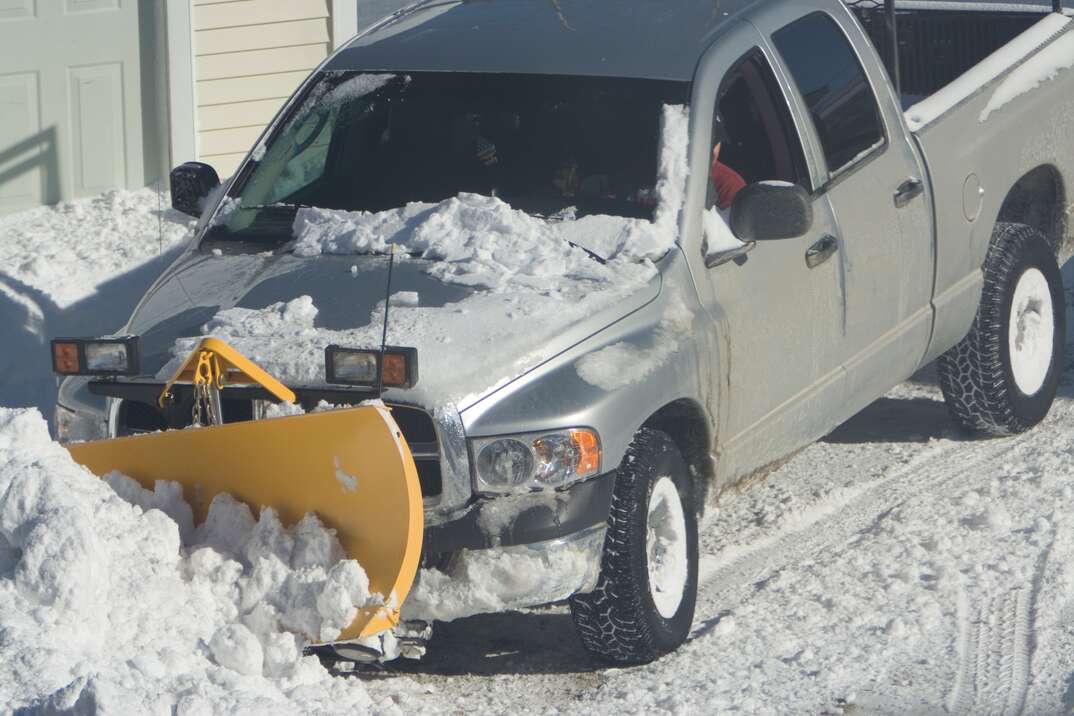This Winter, Plow Your Own Driveway. Use This Guide to Get Started

Tired of shoveling by hand or pushing a snowblower down a long driveway? Or maybe you’re sick of paying for these services. Attaching a plow to your vehicle can make quick work of clearing your driveway on snowy days, so you have more time for other winter tasks, such as dealing with frozen gutters.
This May Also Interest You: How Much Does a Heated Driveway Cost?
Learning how to plow snow correctly will make winter home maintenance a breeze. Here, we’ve broken down how to plow your driveway, start to finish.
How Do You Attach a Plow to Your Vehicle?
You'll need a large truck if you want to attach a snowplow. Snowplows can vary in size and weight, so ensure you choose a size that your truck can handle.
Snowplows require a bracket or front hitch receiver on your vehicle. Once that's installed, you can install and uninstall the plow blade as needed. Many newer models have mount-and-release systems that make it quick and easy to put the blade on and take it off.
How Does a Snowplow Work?
Snowplows mounted to trucks have a hydraulic lift system that lets you raise and lower the blade. The controls vary, from simple joysticks to touchpad controllers with multiple buttons. Consider the complexity of the controls when choosing a plow, so you can learn how to plow snow easily. You can use the controller to change the positioning of the plow and to raise or lower it.
What's the Best Way to Plow Snow?
The easiest way to plow your driveway is to back up as close to the house as possible. Backing into the garage gives you an easy shot at the full length of the drive. Lower the plow and drive to the end of the driveway, pushing the snow to the street. Back up and make additional passes to clear the entire driveway.
If you have a wide driveway, start with a pass down the middle. If you work from one side to the other, you'll create a large mound of snow on one side of the driveway. Working from the middle outward is usually easier to manage.
If you have a short driveway, dragging the snow back is often the easiest method. Drive your truck as far forward into the driveway as you can with your plow up. Lower the plow and back up out of the driveway to pull the snow out with you.
More Related Articles:
- Non-Salt Awesome Sauce Alternatives for De-icing Your Driveway
- Digging Out: 6 Things Homeowners Should Do Right After a Blizzard
- How Much Is Too Much? Here’s a Guide to How Much Snow Your Roof or Deck Can Hold
- Frozen Gutters Be Dammed! 6 Ways to Eliminate Ice Dams
- Prevent Frozen Pipe Problems by Knowing These Things Down Cold
How Fast Should You Plow Snow?
Make slow passes when plowing, keeping your vehicle under 15 miles per hour. Residential driveways typically aren't very long, so going very slow is important to plow safely. Drive slowly and stay alert, watching all sides of your vehicle to check for people, animals and cars. Going slow can prevent damage to your landscaping and plow. If you have a gravel driveway, plowing slowly minimizes how much gravel gets picked up and pushed away by the plow.
Tips for How to Plow Snow
Here are some additional tips on how to plow snow to make the process easier:
- Stake your driveway. Once it's covered with snow, your driveway is difficult to see. Placing stakes at the end of your driveway and every 10 feet help you visualize where it is. This protects your plow and landscaping.
- Do multiple passes. Don't wait until the snow is done falling, especially if you anticipate several inches or blizzard-like conditions. Doing a few passes while it snows makes plowing easier. Plowing is much more difficult with several inches of snow because it's heavy and might start hardening into ice.
- Start high. If the snow is deep or wet and heavy, you might need to start with the plow high. With each pass, drop the blade 1 or 2 inches until you can clear all the snow.
- Find the right spot for snow. Don't just push the snow into the road and leave it. You need to clear the snow out of the road and put it in a place where it won't cause issues. Place the snow somewhere on your property — not on a neighbor's lot. Avoid piling it so high that it blocks visibility.
- Pretreat the driveway. Using salt on the driveway to pretreat it when snow is coming can make plowing easier. It can also give your vehicle traction while you plow.
- Monitor your truck. The weight of the plow and the power it takes to push the snow make your truck work hard. Watch the temperature gauge on your vehicle to make sure it doesn't overheat.
- Finish up by hand. You might need to finish some areas with a shovel or snowblower after you plow. Make sure fire hydrants, mailboxes, sidewalks and other important access points are clear.


